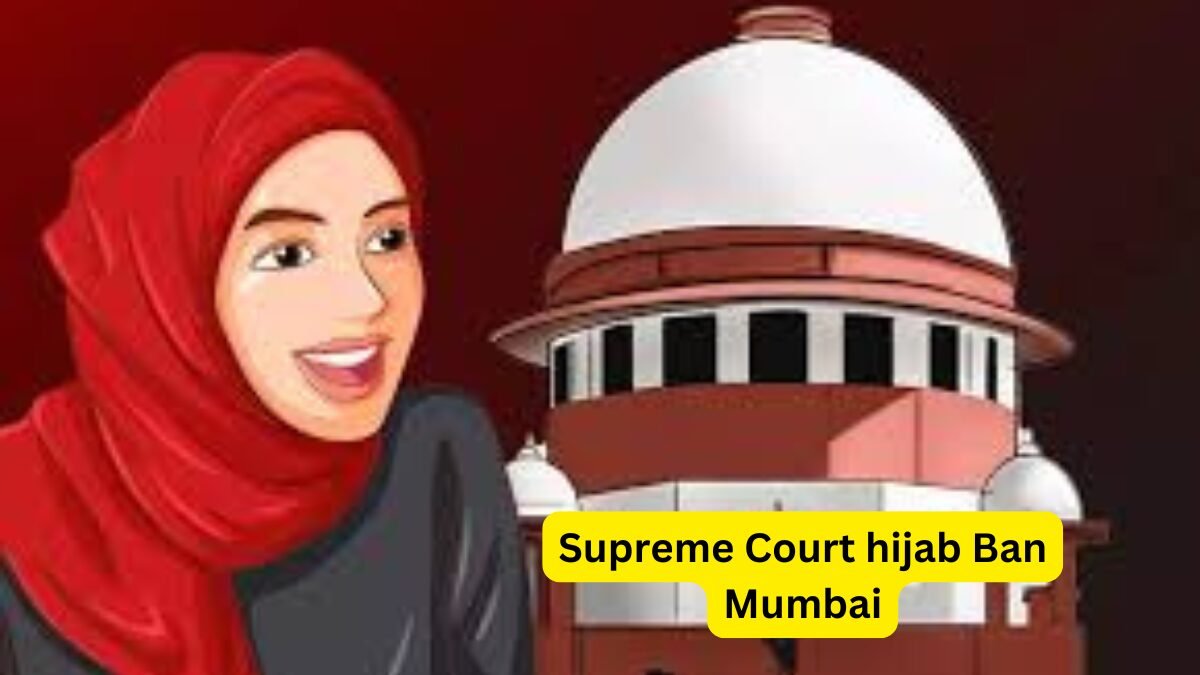Supreme Court hijab Ban Mumbai – India, with its rich diversity of cultures and religions, has always been a melting pot of different beliefs and practices. The Supreme Court, as the apex judicial body, plays a crucial role in upholding the Constitution and protecting the rights of individuals, especially when these rights come into conflict. One such controversy that has recently caught the nation’s attention is the debate over the hijab ban in Mumbai’s educational institutions. This issue, touching upon both religious freedom and the principles of secularism, has led to heated debates and legal challenges.
Background of the Hijab Ban in Mumbai
The controversy began when certain colleges in Mumbai issued a circular banning the hijab, a religious headscarf worn by Muslim women, on campus. The circular, which also extended to other forms of face coverings such as the burqa and niqab, sparked widespread outrage among the Muslim community and civil rights activists.
Initial Circular by Mumbai Colleges
The circular was introduced under the pretext of maintaining uniformity and discipline on campus. However, it quickly became apparent that this move was seen by many as an infringement on religious freedom, guaranteed under Article 25 of the Indian Constitution.
The Debate Surrounding Hijab and Religious Freedom
The hijab has long been a symbol of faith for many Muslim women. While some view it as a personal choice, others see it as a mandatory practice dictated by their religion. The ban raised fundamental questions about the extent to which the state can interfere in religious practices.
Previous Court Rulings on Similar Issues
This is not the first time that the issue of religious attire has come under judicial scrutiny in India. Past rulings have often leaned towards protecting individual rights, but the balance between religious freedom and secularism remains a delicate one.
Supreme Court’s Involvement
As the controversy escalated, the matter was brought before the Supreme Court of India. Petitioners argued that the ban was a violation of their constitutional rights, while the state defended its position on maintaining uniformity in educational institutions.
The Appeal to the Supreme Court
The petitioners, including students and rights groups, challenged the circular on the grounds that it violated their fundamental right to practice and profess their religion. They argued that the ban disproportionately targeted Muslim women and was discriminatory in nature.
Arguments Presented by the Petitioners
The petitioners emphasized that wearing the hijab is an essential practice of their faith and that the ban not only infringed on their religious freedom but also their right to education. They urged the Supreme Court to protect their rights by striking down the circular.
The Government’s Stance on the Matter
On the other hand, the state defended the ban, arguing that it was necessary to maintain discipline and a sense of uniformity in educational institutions. They maintained that the ban was not targeted at any specific community but was a general measure applicable to all students.
The Stay on the Circular
In a significant development, the Supreme Court issued a stay on the circular, effectively halting its implementation for the time being. This decision provided temporary relief to the petitioners but also left the door open for further legal challenges.
Details of the Supreme Court’s Stay
The stay order was issued on the grounds that the circular could have far-reaching implications on the rights of individuals, particularly those belonging to religious minorities. The court emphasized the need to carefully examine the matter before making a final decision.
Immediate Implications for Mumbai Colleges
With the stay in place, colleges in Mumbai are currently not allowed to enforce the hijab ban. This has provided a sense of relief to Muslim students, many of whom had feared the loss of their educational opportunities due to the ban.
Reactions from Students and Religious Groups
The stay order was met with widespread approval from students and religious groups, who saw it as a victory for religious freedom. However, some sections of society, particularly those advocating for strict secularism, expressed disappointment with the court’s decision.
Legal Perspectives on the Hijab Ban
The legal debate surrounding the hijab ban is complex, involving the interpretation of constitutional rights and the principles of secularism.
Interpretation of Religious Freedom Under Indian Law
Under Article 25 of the Constitution, every citizen has the right to freely practice and propagate their religion. However, this right is not absolute and can be restricted in the interests of public order, morality, and health. The challenge lies in determining whether the hijab ban falls within these permissible restrictions.
The Balance Between Uniformity and Religious Expression
One of the key arguments in favor of the ban is the need for uniformity in educational institutions. Proponents argue that allowing religious symbols like the hijab could lead to divisions among students. On the other hand, opponents argue that uniformity should not come at the cost of individual religious expression.
Comparison with International Laws on Religious Symbols in Schools
The debate over religious symbols in schools is not unique to India. Countries like France have implemented strict bans on religious symbols in public schools, while others like the United States have adopted a more permissive approach. The Indian context, however, is unique due to its secular yet pluralistic society.
Social Impact of the Hijab Ban
Beyond the legal aspects, the hijab ban has significant social implications, particularly for the Muslim community in Mumbai.
Effects on Muslim Students in Mumbai
The ban has had a profound impact on Muslim students, many of whom felt alienated and targeted. For some, the ban forced them to choose between their education and their religious beliefs, a choice that no student should have to make.
Public Opinion and Media Coverage
The hijab ban has sparked intense public debate, with opinions sharply divided along ideological lines. While some view the ban as necessary for maintaining secularism, others see it as an attack on religious freedom. Media coverage has been equally polarized, with different outlets taking varying stances on the issue.
Broader Implications for Religious Minorities in India
The hijab ban is part of a broader pattern of challenges faced by religious minorities in India. The outcome of this case could set a precedent for how religious freedom is interpreted and enforced in the country.
Political Ramifications
The hijab ban has also had political consequences, influencing the positions of various political parties and potentially affecting upcoming elections.
How Political Parties Have Reacted
Political parties have been quick to take sides on the issue, with some supporting the ban as a measure to uphold secularism, while others have condemned it as discriminatory. The issue has become a rallying point for both sides, with potential electoral implications.
The Role of Identity Politics in the Debate
The hijab ban has highlighted the role of identity politics in India, where religious and cultural symbols often become flashpoints for larger political battles. The outcome of this case could influence how religious and cultural identity is negotiated in the public sphere.
Potential Influence on Upcoming Elections
With elections on the horizon, the hijab ban could become a key issue for voters, particularly in constituencies with significant Muslim populations. Political parties may use the issue to galvanize support, either by appealing to secular values or by defending religious freedom.
Future Legal Battles
The Supreme Court’s stay on the hijab ban is not the final word on the matter. The case is likely to continue, with significant legal and social ramifications.
What Could Happen Next in the Supreme Court?
The Supreme Court is expected to hear further arguments on the case in the coming months. The final ruling could either uphold the stay, strike down the ban, or impose new conditions on how religious symbols are handled in educational institutions.
Possible Outcomes and Their Consequences
Depending on the court’s final decision, the outcome could have far-reaching implications for religious freedom in India. A ruling in favor of the ban could embolden other institutions to impose similar restrictions, while a ruling against it could reaffirm the protection of religious practices.
The Broader Legal Context of Religious Freedom Cases in India
The hijab ban case is part of a broader legal context in India, where the courts have often been called upon to balance religious freedom with other constitutional values. The outcome of this case could influence how future cases are decided, particularly those involving religious symbols and practices.
Conclusion
The hijab ban in Mumbai has sparked a nationwide debate on the balance between religious freedom and secularism. While the Supreme Court’s stay has provided temporary relief to those affected, the issue is far from resolved. As the case continues to unfold, it will be important to consider the broader implications for religious minorities in India and the role of the judiciary in protecting individual rights.
In this blog, we have provided detailed information on Supreme Court hijab Ban Mumbai. We appreciate you taking the time to read this post about Supreme Court hijab Ban Mumbai in our blog! If you find this information useful, please share this blog with your friends and family so that they can also know about Supreme Court hijab Ban Mumbai. Visit our website homepage weblog365.in to read more interesting and informative blogs and stay updated.

My name is Yogesh Pandey, and I hail from Lucknow, India. I work in digital marketing. I have been blogging since 2023. I write about Technology, Entertainment, Automobile, and Lifestyle providing insights to help others find quality products. I am excited to have the opportunity to collaborate with weblog365.in now. You can reach out to me via email at weblog365.in@gmail.com. Let’s connect! 🙏
